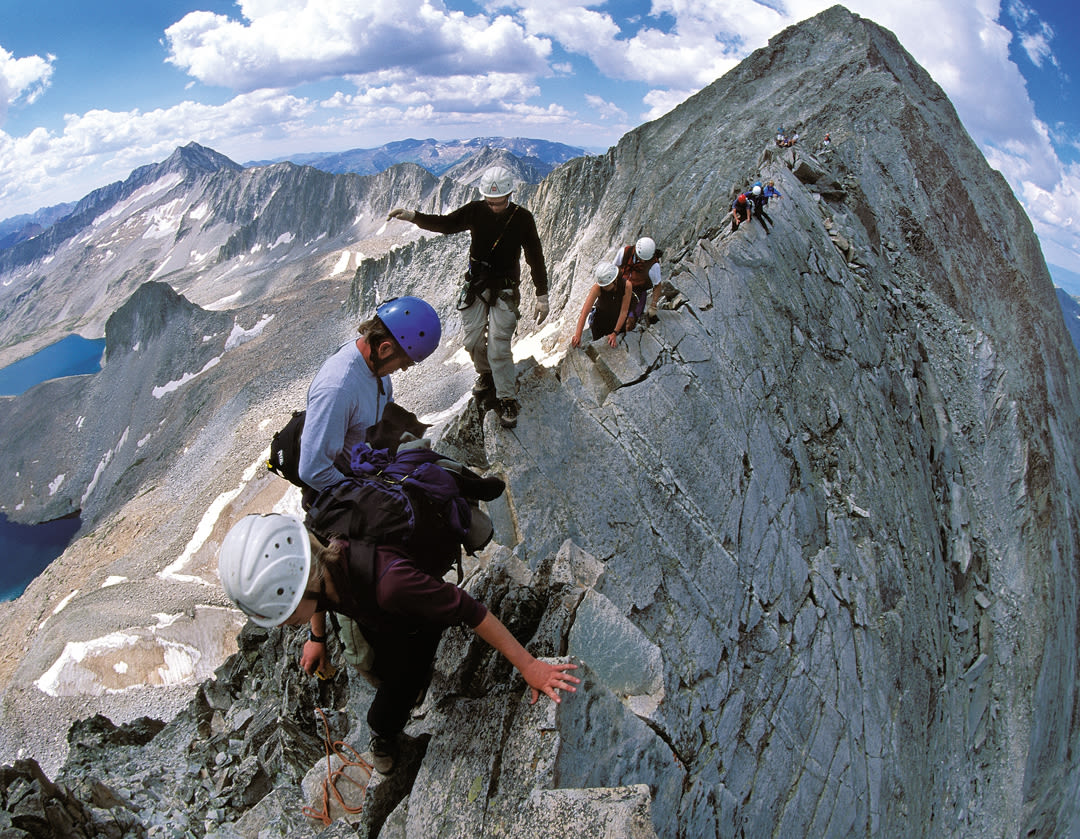A New Program Educates Climbers About Elk Mountain 14ers

Climbers navigate the "knife edge"on Capitol Peak. There is a local mountain safety presentation on September 6, 2018 at 6 p.m., at Mountain Rescue Aspen.
Image: Daniel Bayer
Last summer, an unprecedentedly tragic season unfolded among the rugged, challenging fourteeners in the Elk Mountains. By the end of August, five climbers had died on Capitol Peak, and two on the Maroon Bells. The deaths left families, friends, and local officials reeling.
Seven people died within three months—was it an aberration or the crux point of a trend that needs reversing? A spirited discussion ensued on social media and on websites like 14ers.com. At its heart, the debate came down to the ethos of mountain climbing—self-reliance and adventure—versus the need for public safety measures.
Hoping to help prevent future tragedies, the Pitkin County Sheriff’s Office invited Forest Service representatives, Mountain Rescue Aspen (MRA), and local guides to meet over the winter and formulate an education campaign. Said Sheriff Joe DiSalvo last September, “Just because [peak climbing] is a recreational thing doesn’t give it less credibility as a public safety hazard. I don’t think we’re going to get to all people, but we need to make a real attempt.
This summer, those participants—now branded as the Elk Mountain Safety Coalition—introduced a multi-pronged approach that includes free presentations, discounted field courses, brochures, and outreach at trailheads. Each stakeholder contributed $5,000 toward the program’s first year. (In a separate but related effort, the Aspen Skiing Company’s employee-funded Environmental Foundation granted $5,000 to the Colorado Fourteeners Initiative to produce safety videos.)
“We want to instill making good decisions and knowing your limitations,” says MRA President Justin Hood. That includes recognizing fatigue, incoming weather, or anything else that could adversely affect a climb and, accordingly, being willing to turn around. “The mountain isn’t going anywhere,” emphasizes Hood.
From late June through early September, six free 90-minute presentations are being held on the Front Range (where many aspiring Elk peak baggers live); two more will take place in the Roaring Fork Valley. Led alternately by Aspen Expeditions owner and lead guide Amos Whiting and Aspen Alpine Guides managing partner Steve Szoradi, the talks cover topics like dealing with the Elks’ loose, rotten rock (more dangerous than on other Colorado fourteeners); setting realistic goals; and route finding through sometimes confusing terrain. MRA volunteers will explain what a rescue entails. Semantics are important, too. “We’re trying to change the vocabulary,” says Szoradi. “This is not hiking, it’s mountaineering.”
Traditional mountaineering emphasizes learning technique and safety by progressing from easier to harder peaks. Whether it’s due to a penchant for instant gratification, today’s “go harder, go higher” fitness mentality, or even the quest for Instagrammable moments, that approach seems to have been eclipsed, but “it’s a learning curve that needs to happen,” Szoradi says.
The one-day field clinics, costing just $50 per person, will take place in the Independence Pass area and include hands-on instruction.
Of course, the outreach touts the benefits of hiring a guide, but doing so still requires a basic skill foundation and acclimatization to tackle the hardest peaks. Said DiSalvo last fall, “I don’t think you come from Brooklyn on Wednesday, hire a guide on Thursday, and climb Capitol on Friday.”
Though last fall the Forest Service added some trailhead signage about the dangers of climbing in the Elks, the coalition hopes to reach people sooner, in time to affect decision-making. Says Karen Schroyer, district ranger for the Aspen-Sopris Ranger District of the White River National Forest, “Our experience has been that once people have decided to climb a peak, they are generally not stopping at a trailhead to read a sign; they’re focused on their goal.”
Nonetheless, on select days this summer, Forest Service rangers and MRA volunteers will be at popular trailheads to connect with climbers on their way to and from peaks. “We want to interview people to find out what went well, what didn’t go well, and see if we can get closer to what some of the problems are,” says Hood.
Despite the intensified outreach, risk on the high peaks will always exist, a fact that longtime mountaineers have come to accept—and perhaps even embrace—as part of the sport. But as DiSalvo pointed out when convening the coalition, the effort to heighten safety and awareness is still warranted.
“I don’t see us solving all of the issues this summer,” says Schroyer. “But if we know that one person chose to take an intro to mountaineering class before climbing these peaks, or if one person picked another peak to climb because they realized after going to one of these presentations that they weren’t ready, to me we’ve succeeded.”
Local mountain safety presentation, Sept 6, 6 p.m., at Mountain Rescue Aspen, with one more TBA; local field courses, July 15 and 21, Aug 5 and 25, Sept 2, 8, 16, and 22. For more info, go to facebook.com/elkrangemtnsafety.














































